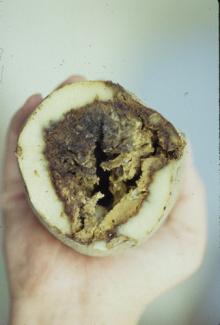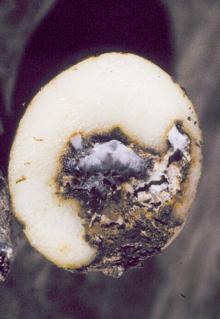Cause Several Fusarium spp., including F. sambucinum, F. solani var. coeruleum and F. avenaceum, can cause dry rot. These fungi survive on refuse and live in soil. Infections can originate from infested seed tubers. Tuber rot usually does not occur unless the tuber is injured during harvest. Wounds provide a way for the fungus associated with soil to enter the tuber. Dry rot is one of the most common storage diseases in Idaho. Fusarium dry rot leads to secondary infections by soft rot bacteria.
Symptoms A dry rot of the tuber starts from a wound or bruise and is at first small and brown. Mold on the rotting tuber may be white, rose, or violet. As the rot progresses, a cavity begins to form, the tuber mummifies and ultimately only the dry shell persists.
Lesions from F. solani var. coeruleum infections start at the side of the infection and progress in a fairly uniform manner through the tuber. As lesions age, rots turn yellow to brown. Lesions caused by F. sambucinum tend to be very dark brown to black and progress through the tuber in a very irregular manner sometimes called "tunneling."
Cultural control
- Be sure tubers mature and skins are well "set" before harvest.
- Avoid wounding and bruising tubers by handling carefully.
- Harvest during dry, cool weather.
Chemical control Apply fungicides as tubers enter storage. Caution: In some locations, some strains of Fusarium have developed resistance to the benzimidazoles such as Decco Salt No. 19 and Mertect 340-F.
- CruiserMaxx Potato (Group 12) at 0.19 to 0.27 fl oz/100 lb seed pieces. 12-hr reentry.
- CruiserMaxx Potato Extreme (Group 3 + 12) at 0.31 fl oz/100 lb seed pieces. 12-hr reentry.
- CruiserMaxx Vibrance Potato (Group 7 + 3 + 12) at 0.5 fl oz/100 lb seed pieces. 12-hr reentry.
- Decco Salt No. 19 (Group 1) at 5.67 g/2,000 lb of potatoes.
- Evolve Potato Seed Piece Treatment (Group 1 + 27 + M3) at 0.75 lb/100 lb seed pieces.
- Maxim MZ (Group 12 + M3) at 0.5 lb/100 lb seed pieces or Maxim 4FS at 0.08 to 0.16 oz/100 lb seed pieces. 12-hr reentry for Maxim 4FS; 24-hr reentry for Maxim MZ.
- Mertect 340 F (Group 1) at 0.42 fl oz/2,000 lb of unwashed tubers on a conveyor line with tumbling action. Tubers should tumble to ensure complete coverage. If another treatment is necessary before cutting and shipping seed tubers, mist at the same rate as above or soak 20 sec in 42 fl oz/100 gal water. Adding water in these sprays requires drying potatoes after treatment. Run the air system without humidification until all tuber surfaces are dry, even within the pile.
- Regalia (Group P5) at 1 to 4 quarts/A as an in-furrow treatment. Does not benefit from the addition of an adjuvant. 4-hr reentry. O
Biological control
- Amplitude ST at 3.2 to 4.8 fl oz/100 lb seed pieces. 4-hr reentry. O
- Bio-Save 10 LP is registered for control of Fusarium dry rot, research in Montana and Idaho has shown this product to substantially reduce losses. Store product under refrigeration or in the freezer until used. Add 250 g of Bio-Save 10 LP to 15 gal of non-chlorinated water and drip or spray overhead prior to storage.
- Stargus at 6 to 8 fl oz per 1,000 ft row as an in-furrow treatment, 3 to 4 quarts/A as a soil drench on 10- to 14-day intervals, or 3 to 4 quarts/A as a chemigation drip treatment on 14- to 21-day intervals. Preharvest interval is 0 days. 4-hr reentry. O
References Jacobsen, B. 1999. Montana Crop Health Report, Montana State University Extension Service Vol. 12, No. 8.
Ocamb C.M., Hamm, P.B., and Johnson, D.A. 2006. Benzimidazole resistance of Fusarium species recovered from potatoes with dry rot from storages located in Columbia Basin of Oregon and Washington. American Journal of Potato Research: 84:169-177.




